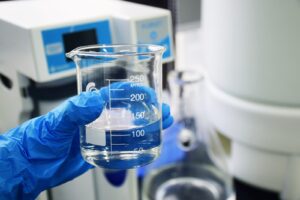Simple new method destroys forever chemicals
Using low temperatures and inexpensive reagents, a research team from Northwestern University have developed a process to destroy two major ‘forever chemicals’.
PFAS, a group of manufactured chemicals used commonly since the 1940s, are called ‘forever chemicals’ because they are unable to be diluted by water or destroyed by fire or bacteria.
They are often used as nonstick and waterproofing agents, and are commonly found in nonstick cookware, waterproof cosmetics, firefighting foams, water-repellent fabrics and products that resists grease and oil.
If these toxic chemicals are buried, they leach into the surrounding soil, becoming a persistent problem for future generations.
Over the years, PFAS has made its way into our drinking water and even into the blood of 97% of the US population.
This new simple technique potentially could be a powerful solution for finally disposing of these harmful chemicals, which are linked to many dangerous health effects in humans, livestock and the environment.

‘PFAS has become a major societal problem,’ said Northwestern’s William Dichtel, who led the study. ‘Even just a tiny, tiny amount of PFAS causes negative health effects, and it does not break down. We can’t just wait out this problem. We wanted to use chemistry to address this problem and create a solution that the world can use. It’s exciting because of how simple — yet unrecognized — our solution is.’
Although the health effects are not yet fully understood, PFAS exposure is strongly associated with decreased fertility, developmental effects in children, increased risks of various types of cancer, reduced immunity to fight infections and increased cholesterol levels.
With these adverse health effects in mind, the U.S. Environmental Protection Agency (EPA) recently declared several PFAS as unsafe — even at trace levels.
‘Recently, the EPA revised its recommendations for PFOA essentially down to zero,’ Dichtel said. ‘That puts several PFAS into the same category as lead.’
The secret to PFAS’s indestructibility lies in its chemical bonds. PFAS contains many carbon-fluorine bonds, which are the strongest bonds in organic chemistry.
But, while studying the compounds, Dichtel’s team found a weakness. PFAS contains a long tail of unyielding carbon-fluorine bonds. But at one end of the molecule, there is a charged group that often contains charged oxygen atoms.
Dichtel’s team targeted this head group by heating the PFAS in dimethyl sulfoxide — an unusual solvent for PFAS destruction — with sodium hydroxide, a common reagent. The process decapitated the head group, leaving behind a reactive tail.
‘That triggered all these reactions, and it started spitting out fluorine atoms from these compounds to form fluoride, which is the safest form of fluorine,’ Dichtel said. ‘Although carbon-fluorine bonds are super strong, that charged head group is the Achilles’ heel.’
Photo by RephiLe water












